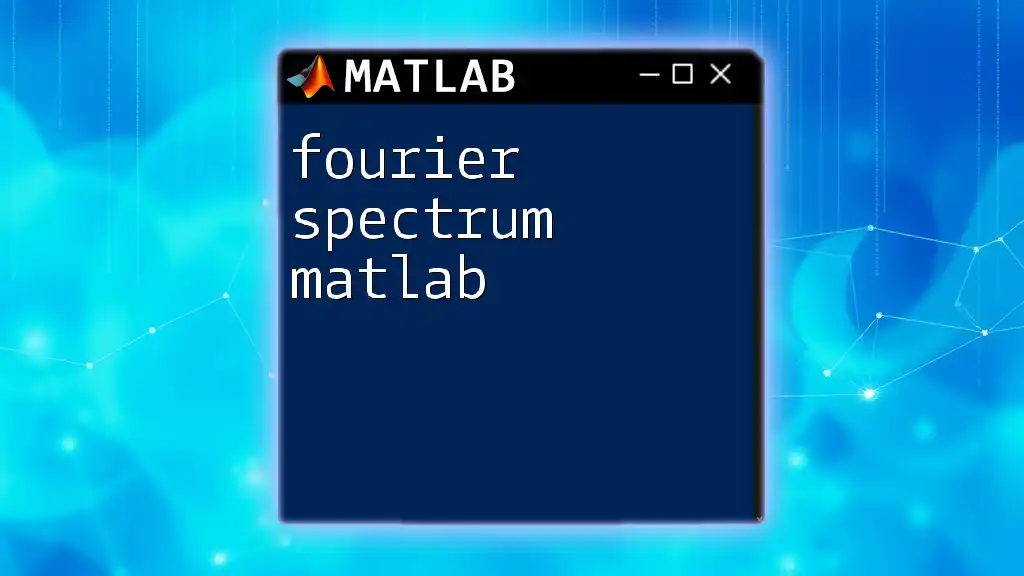The `pspectrum` function in MATLAB computes the time-frequency spectrum of a signal, helping to visualize its frequency components over time.
% Example of using pspectrum to analyze a signal
t = 0:0.001:1; % Time vector
x = chirp(t,0,1,500); % Generate a chirp signal
pspectrum(x,1000); % Compute and plot the power spectrum
What is `pspectrum`?
The `pspectrum` function in MATLAB is designed for spectral analysis, enabling users to analyze the frequency components of a signal. This function provides a time-dependent spectral estimate, making it essential for understanding how signal characteristics evolve over time. Unlike traditional methods such as the Fast Fourier Transform (FFT) or the Welch method (`pwelch`), `pspectrum` offers a real-time, time-frequency representation of the signal, which is particularly useful for non-stationary signals where frequency content varies over time.

Understanding Spectral Analysis
Spectral analysis is a powerful tool used in various fields such as engineering, audio processing, and biomedical research. It helps to decode the frequency content embedded in a signal, allowing users to identify dominant frequencies, noise sources, and trends over time. The transition from time-domain analysis to frequency-domain analysis is facilitated by leveraging functions like `pspectrum`, which accurately reflects how signal energy is distributed across different frequencies.

Syntax of `pspectrum`
The basic syntax of the `pspectrum` function is as follows:
pspectrum(x)
Here, `x` represents the input signal. However, several optional parameters can be included to enhance the analysis:
- Windowing options: Specify different windowing functions for better frequency resolution.
- Frequency resolution: Control how finely the frequency range is sampled.
- Time averaging settings: Manage the amount of data averaged over time, which is pivotal for noisy data.
A common usage of `pspectrum` includes specifying the sampling frequency `fs`:
pspectrum(x, fs)
Where `fs` stands for the sampling frequency of the signal.

How to Use `pspectrum` in MATLAB
Step-by-Step Guide
Step 1: Prepare Your Data
Before utilizing `pspectrum`, ensure that your data is well-prepared. This includes generating or acquiring a signal that you wish to analyze. Here's an example of how to create a simple noisy cosine wave:
fs = 1000; % Sampling frequency
t = 0:1/fs:1-1/fs; % Time vector
x = cos(2*pi*50*t) + randn(size(t)); % Signal with noise
In this example, a cosine wave with a frequency of 50 Hz is mixed with random noise.
Step 2: Basic `pspectrum` Application
Once the data is prepared, you can directly apply the `pspectrum` function on the signal:
pspectrum(x, fs)
This command provides a basic visualization of the spectral density of the signal, allowing users to observe and analyze the frequency components.
Visualizing Spectral Data
Visualizing the results from `pspectrum` is crucial for understanding the output. The generated plot typically shows the frequencies on the x-axis and the power spectral density on the y-axis. Understanding this representation helps in identifying peaks that indicate dominant frequencies in the signal.
Example Visualization Code:
To enhance the visualization process, you can extract the power spectral density (PSD) and frequency vectors from `pspectrum` and plot them in decibels:
[pxx, f] = pspectrum(x, fs);
plot(f, 10*log10(pxx)) % Convert to dB scale
title('Power Spectral Density')
xlabel('Frequency (Hz)')
ylabel('Power/Frequency (dB/Hz)')
This code snippet allows you to plot the PSD in decibels, which is often more intuitive when analyzing signal strength across different frequencies.

Advanced Features of `pspectrum`
Using Windowing Functions
Windowing functions play a vital role in spectral estimates, helping to reduce spectral leakage and improve frequency resolution. The `pspectrum` function allows users to specify various windowing methods such as Hanning, Hamming, and Blackman windows. Each of these has its advantages depending on the characteristics of the signal.
Example of Using a Window:
To apply a Hamming window for improved spectral resolution, you can do the following:
window = hamming(256);
pspectrum(x, fs, 'Window', window)
This command applies the specified window to the signal before computing the spectrum, helping to minimize the edge effects and smoothing the resulting spectral estimate.
Specifying Frequency Limits
Focusing on specific frequency ranges can yield more insightful analyses. The `FrequencyLimits` option enables you to filter results to a particular range.
pspectrum(x, fs, 'FrequencyLimits', [0 100])
This command focuses the spectral analysis on frequencies between 0 and 100 Hz, allowing you to zoom in on the relevant data.

Applications of `pspectrum` in Real-World Scenarios
Signal Analysis in Engineering
In engineering, `pspectrum` can be used for analyzing vibration signals from machinery, helping to identify wear patterns or imbalances. For instance, an engineer might apply `pspectrum` to vibration data to detect undesirable frequency spikes indicating potential mechanical failures.
Audio Signal Processing
In the realm of music and audio processing, `pspectrum` aids in understanding harmonic content and the overall spectral balance of audio signals. For musicians and sound engineers, analyzing the spectral characteristics during mix-down processes can inform decisions about equalization and other effects.
Biomedical Signal Analysis
Medical professionals can apply `pspectrum` to analyze signals such as EEG or ECG data. By understanding the spectral components, practitioners can gain insights into patient conditions or the efficacy of treatments based on the signal behavior.

Troubleshooting Common Issues
Users may encounter common errors while using `pspectrum`, such as dimension mismatches or unsupported signal types. Here are some strategies to overcome such issues:
- Check data dimensions: Ensure that the signal is a one-dimensional array.
- Confirm sampling frequency: Make sure that the sampling frequency is accurately defined.
- Review window properties: Make sure the specified window size matches the length of the signal being analyzed.

Conclusion
The `pspectrum matlab` function is a powerful tool for conducting spectral analysis. Its ability to provide real-time, time-frequency representations makes it an invaluable asset for users working with non-stationary signals. By exploring optional parameters and advanced features, practitioners can gain deeper insights into their data.
Experimenting with the examples in your MATLAB environment will solidify your understanding and potentially reveal new applications tailored to your specific needs.

Call to Action
Take the time to implement the examples discussed in this article to enhance your proficiency with the `pspectrum` function. Engage with the MATLAB community and explore additional resources to expand your knowledge of spectral analysis.

Additional Resources
For further exploration of the `pspectrum` function, consult the official MATLAB documentation. This provides in-depth tutorials and examples, pushing your understanding of spectral analysis to new heights.

Frequently Asked Questions
What types of signals can `pspectrum` analyze?
The `pspectrum` function can analyze a wide range of signals from continuous waveforms to discrete-time signals, making it versatile across various applications.
How does `pspectrum` compare to FFT?
While `pspectrum` provides a time-frequency representation useful for non-stationary signals, FFT is better suited for stationary signals, offering a direct frequency analysis without the time component.
Can I customize plots generated by `pspectrum`?
Yes! MATLAB allows for extensive customization of plots through settings in the `plot` function, enabling changes in colors, line styles, and axis labels to better represent your data.
With these insights and guidance, you are now equipped to harness the power of `pspectrum` for effective spectral analysis in MATLAB.

















